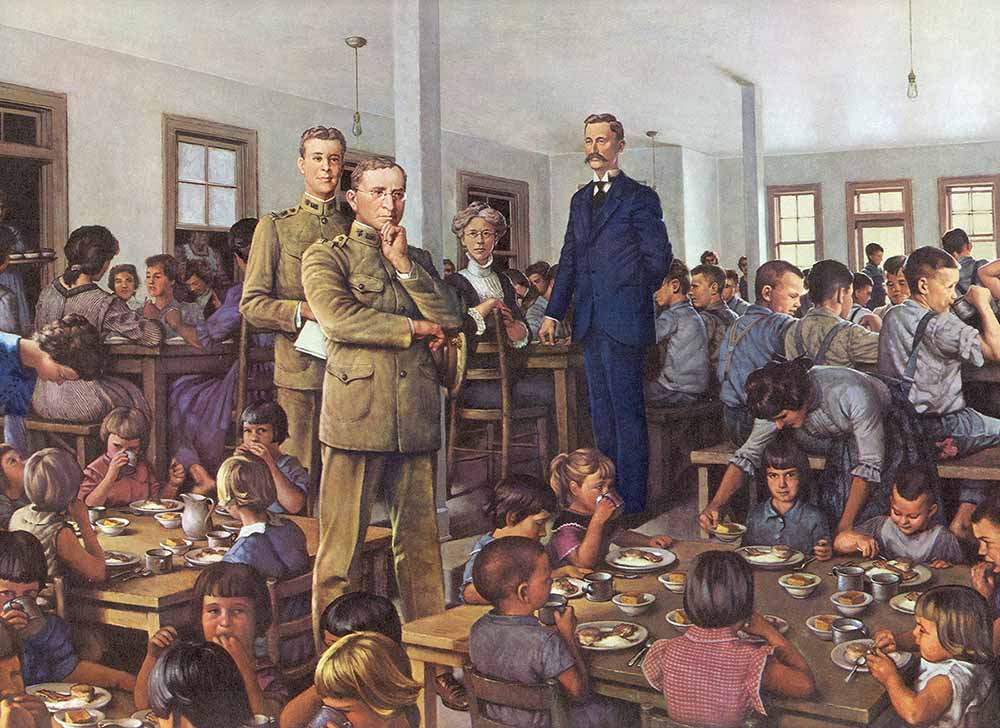Portraits of Pellagra

Pellagra, caused by a deficiency of vitamin B3 (niacin), was one of the most significant public health issues at the beginning of the 20th century. Between 1900 and 1940, three million cases of pellagra were recorded in the United States alone, resulting in one hundred thousand deaths. Doctors identified the disease by the “four Ds”: diarrhea, dementia, dermatitis (or skin rashes), and death.
At the time, most doctors viewed pellagra as an infectious disease. Like cholera and typhus, pellagra was much more common in neighborhoods with poor or non-existent sanitation and generally poor health conditions. This belief was challenged by Dr. Joseph Goldberger (1874-1929) when he began researching pellagra in 1914. Goldberger spent most of his career investigating the cause and treatment of pellagra. In the dozens of orphanages and mental hospitals he visited, there were hundreds of pellagra cases, yet there were no cases among the doctors and nurses who were in constant contact with the patients. This did not fit the pattern of an infectious disease.
Goldberger quickly focused on another possible culprit: a monotonous diet. At that time, many people obtained most of their calories from three foods: cornmeal, molasses, and dried meat. Goldberger was very excited. He could already prove that adding fresh foods to people’s diets could stop pellagra. He conducted clinical research at Rankin Prison in Mississippi. Through these studies, he demonstrated that he could induce pellagra by depriving people of fresh foods. Pellagra was not a microbial disease but a disease caused by malnutrition and ultimately poverty.
While providing patients with a balanced diet to research foods containing the “pellagra-preventing factor” (later named niacin), he wrote about how poverty and racism made access to healthy foods difficult: “There is a very marked disproportion in the prevalence of pellagra among the two races. The explanation…can be found in the differences in economic conditions.”
However, Southerners soon began accusing Goldberger of propaganda and falsifying his experimental results regarding pellagra. One doctor even condemned him for “crucifying” pellagra victims. This hostility bewildered him. He only wanted to treat a disease, not reignite the Civil War. But as he continued to step back, his opponents became more insistent, claiming that pellagra was an infectious disease unrelated to poverty or malnutrition. Nevertheless, he persisted and proved pellagra was due to deficiency, using himself and many friends as subjects.
Goldberger believed that doctors needed additional training to recognize the skin and other clinical signs of pellagra, so in 1919, he wanted to have color portraits made of patients in hospitals in Georgia and South Carolina. The portraits needed to be in color “because in those days, there was no color photography, and it was impossible to understand pellagra lesions through black and white photographs.”
He searched for an artist to make the colored illustrations and began working with portrait artist John Wesley Carroll (1892-1959). This collaboration resulted in a collection of 41 detailed illustrations of patients with pellagra. Carroll had previously been commissioned during World War I to create anatomical lithographs of injuries, which had caught Goldberger’s attention.
While visual depictions of pellagra from that era typically showed emaciated bodies, Carroll’s drawings lent a dignity of portrait art to the patients. The portraits showed pellagra dermatitis on the face and neck, including the Casal necklace. More importantly, the similarities among the clinical images helped challenge the racist belief of that time that dermal plaques were harder to detect in darker-skinned patients.
John Wesley Carroll’s lithographs from World War I were never found, making the pellagra portraits his only known set of medical illustrations. However, he had a long career as an artist, continuing to capture ordinary people and painting portraits of veterans he encountered in everyday life, much like the pellagra patients he depicted.
The pellagra portraits were discovered by nutrition epidemiologist Dr. William Henry Sebrell Jr. between 1950 and 1955. When Dr. Sebrell retired, the paintings were donated to the National Institutes of Health. Someone decided the paintings were trash and they were nearly thrown out, but they were saved by archivist Anne Meyers and donated to the Eskind Biomedical Library at Vanderbilt University. The donated paintings were matched with clinical notes written by Goldberger by Dr. William F. Tanner, who oversaw daily nutrition studies with pellagra patients.
Initially, it was unclear who had created the portraits. Each portrait bore only the initials “JC,” which were thought to stand for “Joseph Goldberger.” However, this theory was disproven by an FBI handwriting analysis, which identified “John Carroll” as the artist.
In a time when some doctors still believed pellagra was contagious, Carroll spent hundreds of hours in close proximity to 41 patients, demonstrating care and empathy for individuals marginalized by poverty, racism, and disease. His use of portraiture, previously reserved for the elite, to make their existence visible was the first step in art’s fight against discrimination and stigma.









